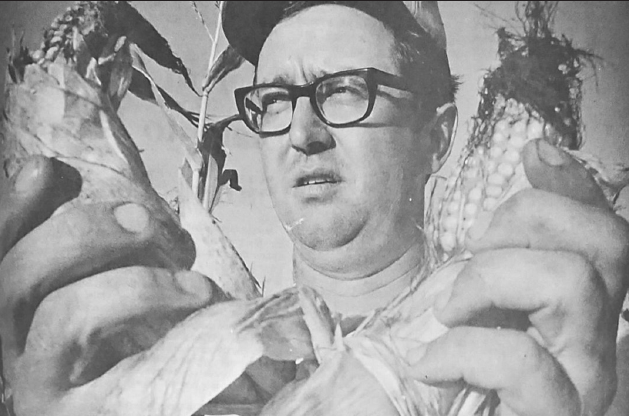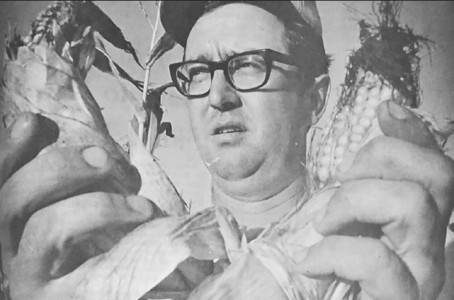Farmers await harvest with optimism

PARTIALLY FILLED ears are Robert Holm’s his biggest problem this year at his farm three miles west of Klossner. Inadequate rainfall and poor pollination caused stubby partially filled cobs in his 25-acre field of corn. The wet spring-dry summer growing season has taken a heavy corn yield toll. (Photo by Steve Kohls)
Although farmers still say they won’t be enjoying a full harvest this year, most display optimism when talking about their corn and soybeans.
Soybeans especially have been helped by recent rainfall, which helped the pods fill out.
“MY SOYBEANS look real good,” said LaRay Kral of Rt. 2, New Ulm.”I checked them out and they look wonderful.”
He said there’s enough moisture now for both his soybeans and corn to reach harvest stage.
Although he chopped one 11-acre field of corn, Kral sees a 67 per cent crop of corn. He sees nearly a full harvest for soybeans.
ROBERT BERANEK, Rt.1, New Ulm, looks for a 50-60 per cent corn crop and an 80 per cent soybean crop. He says he could still use more moisture.
“During the last rain we got 3 1/2 inches,” he said. “But it came a little too fast. Much of it ran off.”
Moisture has been spotty, with farms in some areas receiving heavy rainfall while other farms have remained virtually dry.
The impact of the moisture on corn remained a question mark, with some ears filling out and denting, other ears yielding only a few kernels.
EDMUND L. BERG, Rt. 2, New Ulm, has chopped about 50 acres of corn. He has 160 acres total, with the corn looking good in low spots, not so good in high spots.
“I guess that’s fairly general in this area,” Berg said. “It won’t be a normal yield, but we’ll get some corn.”
His soybeans look good, but some plants on high, dry ground show signs of failing.
Farmers in most areas also report good oats and wheat crops, with some having yields better than those in 1974.
Kral said his wheat was better than last year, while Berg said both his oats and wheat were better than last year.
Reports from counties in this area include:
BROWN COUNTY
Corn has taken advantage of the rain, said Lerry Peichel, county extension agent.
“I think we have a few isolated fields that will do better than 90 to 100 bushels an acre,” Peichel said.”We also have fields where there’s not an ear in the field.”
County average will be about 40-60 bushels an acre for corn. Soybeans will hit about 70 per cent of normal.
Oats and wheat crops were good.
NICOLLET COUNTY
Corn crop will range from 50-75 per cent of a full crop.
Soybean yields will be better than corn, with a 90 per cent harvest seen.
“I really feel the corn is beyond total help,” said Greg Luehr, county extension agent.
Oats yields varied from area to area.
RENVILLE COUNTY
Corn yield is expected to be 65 per cent of a normal year, with soybeans expected to be 80 per cent of a normal year.
“In some places,” said Pat Maher, county extension agent,”there are no ears of corn in the fields. Our soybean crop was not hurt as bad.”
Most farmers here have adequate moisture, at least for awhile.
REDWOOD COUNTY
Corn yields will range from just a few bushels up to 90 bushels an acre. As for soybeans, said Ernie Johnson, county extension agent,”we expect fairly good yields.
“We’re hurting for moisture, though. Rain has been spotty.” Oats yielded 65-75 bushels an acre.
SIBLEY COUNTY Corn is filled out well in most areas. Soybeans look good.
John Peterson, county extension agent, said farmers here still could use more moisture.
Oats yielded 60-80 bushels an acre.
WATONWAN COUNTY
Corn yield of about 47 bushels an acre is projected by John Ankeny, county extension agent.
Soybeans look like they will yield better than the corn, Ankeny said.
Moisture is adequate on the surface, but more subsoil moisture is desirable.
Oats and wheat yields were good.
McLEOD COUNTY
Farmers here are looking at the corn crop with optimism, said Chuck Leifeld, associate county agent. Leifeld said the corn crop is expected to be about 85 per cent of a normal year.
Soybean yields are expected to be about 25 bushels an acre.
Moisture is adequate, but more could be used.
Oats and wheat crops yielded below a normal year.
New Ulm Daily Journal
Sept. 4, 1975


